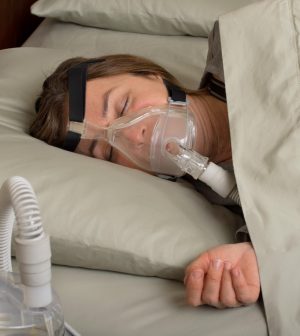- Navigating Your Midlife Crisis: Embracing New Possibilities
- City Raccoons Showing Signs of Domestication
- Mapping the Exposome: Science Broadens Focus to Environmental Disease Triggers
- One Week Less on Social Media Linked to Better Mental Health
- Your Brain Changes in Stages as You Age, Study Finds
- Some Suicide Victims Show No Typical Warning Signs, Study Finds
- ByHeart Formula Faces Lawsuits After Babies Sickened With Botulism
- Switch to Vegan Diet Could Cut Your Greenhouse Gas Emissions in Half
- Regular Bedtime Does Wonders for Blood Pressure
- Dining Alone Could Mean Worse Nutrition for Seniors
Sleep Apnea Linked to Weaker Bones, Teeth

People who have sleep apnea may have another issue to worry about — weaker bones and teeth.
Known as low bone-mineral density, the condition is an indicator of osteoporosis and can increase the risk of fractures and cause teeth to become loose and dental implants to fail, according to new research from the University at Buffalo (UB) in New York.
To study this, researchers used cone beam computed tomography (CBCT) — a type of X-ray — to measure bone density in the heads and necks of 38 adults. Half of the study participants had sleep apnea.
These scans found that participants with sleep apnea had significantly lower bone-mineral density than the participants without the condition.
Sleep apnea can cause difficulty breathing while asleep, which can lead to low levels of oxygen in the body, inflammation, oxidative stress and shortened breathing patterns.
These symptoms may each have a chronic negative effect on bone metabolism and eventually bone density, said senior author Dr. Thikriat Al-Jewair. She is an associate professor of orthodontics in the UB School of Dental Medicine and director of the school’s Advanced Education Program in Orthodontics.
“While the link between obstructive sleep apnea and low bone-mineral density has yet to be fully explored, this study offers new evidence on their connection that could have several implications for orthodontic treatment,” Al-Jewair said in a university news release.
“If a patient has been diagnosed with sleep apnea, this can influence treatment planning and management. CBCT imaging has become an integral part of daily orthodontic practice and could be used as a screening tool for low bone-mineral density,” she said.
“Orthodontists could then inform their patients of their propensity for low bone-mineral density and encourage them to seek further consultation with their physician, as well as warn the patient of possible adverse outcomes, increased risks and effects on treatment time,” Al-Jewair added.
Al-Jewair also suggested future research needs to be done with larger sample sizes.
The findings were published recently in The Journal of Craniomandibular and Sleep Practice.
More information
The U.S. National Heart, Lung, and Blood Institute has more on sleep apnea.
SOURCE: University at Buffalo, news release
Source: HealthDay
Copyright © 2025 HealthDay. All rights reserved.










